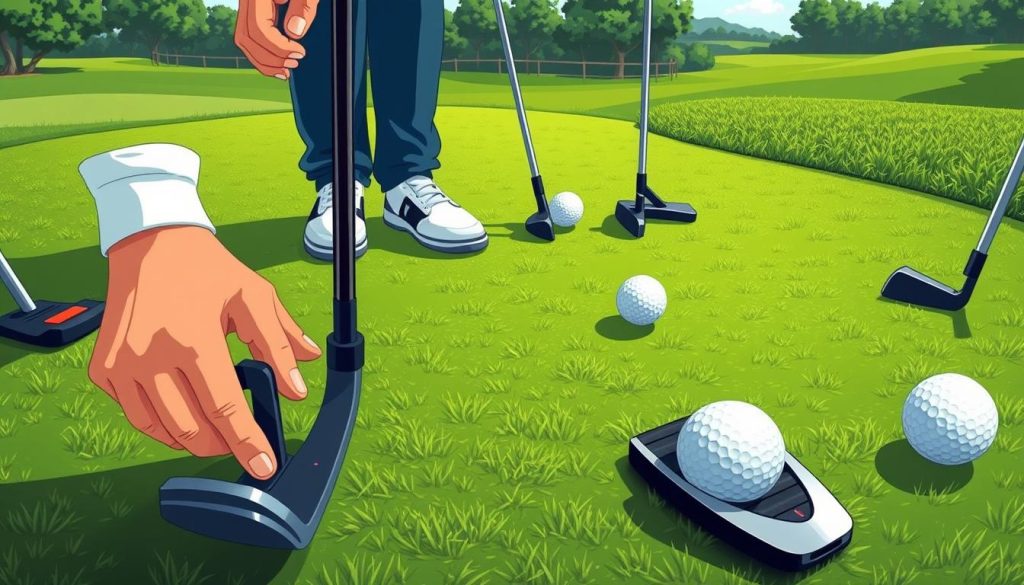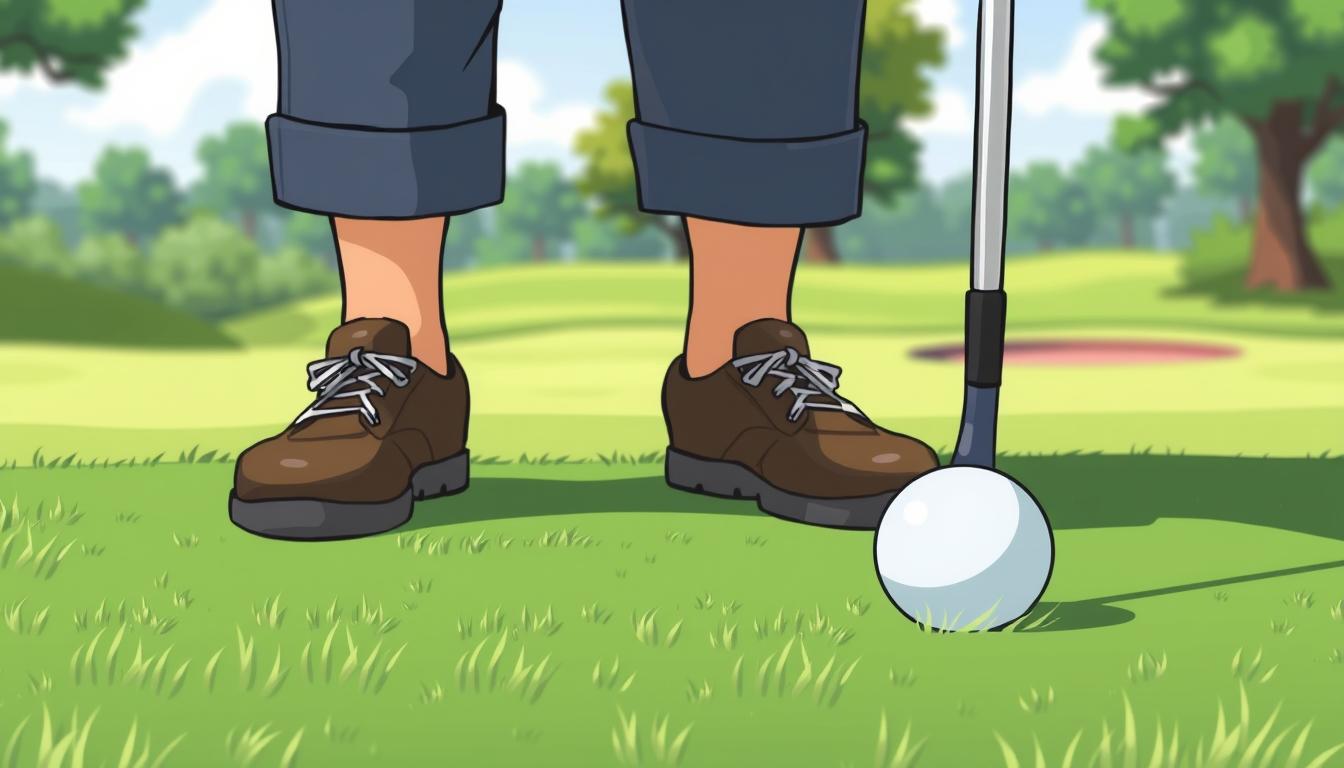Improving your putting stroke is key to lowering your golf scores. This guide shares expert tips to boost your short game. You’ll learn how to strike the ball consistently, thanks to better golf swing mechanics and stroke technique.
Brad Faxon, known as one of golf’s top putters, stresses the need for a smooth, natural stroke. His methods, along with insights from other pros, are the core of this guide. You’ll discover how to fine-tune your stroke, improve your setup, and gain a winning mindset on the green.
Key Takeaways
- Maintain a 2:1 backswing to downswing ratio for consistent putting
- Match putter length to your natural stance for optimal performance
- Use a light grip pressure to allow for a freer putter head swing
- Focus on proper alignment and visualization for improved accuracy
- Practice with small targets to enhance putting precision
- Develop a pre-putt routine to build consistency and confidence
Understanding the Fundamentals of a Perfect Putting Stroke
Mastering the putting stroke is key to bettering your golf game. A perfect stroke mixes science, body alignment, and precise impact. Let’s explore these essential elements of golf swing mechanics to boost your stroke technique.
The Science Behind Stroke Mechanics
The putting stroke is known as the “game within the game” for its unique mechanics. Unlike other swings, putting needs a delicate pendulum-like motion for accuracy. Focus on these four key areas:
- Grip
- Stance
- Aim
- Stroke
Role of Body Alignment
Proper body alignment is vital for a successful putting stroke. Stand with your feet shoulder-width apart, knees slightly bent, and hips aligned over your feet. Square your shoulders to the target and keep your head centered over the ball. This stance helps you have a smooth, controlled stroke with your hands close to your body.
Impact Position Essentials
The impact position is where your putter meets the ball. To get consistent results, focus on these key points:
| Aspect | Description |
|---|---|
| Alignment | Ensure your putter face is square to the target line |
| Direction | Maintain a straight back and through motion |
| Speed | Control the length and tempo of your stroke for proper ball speed |
Even top players have some wrist movement due to the natural swinging of the putter head. By focusing on these basics, you’ll improve your putting stroke and lower your scores.
Mastering the Tempo: The 2:1 Ratio Secret
Tempo is key in your putting stroke guide. The 2:1 ratio is a secret to hitting the ball consistently. It means your backswing should be twice as long as your downswing. Top golfers use this ratio for smooth, repeatable putts.
Use a metronome set at 72 to 80 beats per minute to get this tempo right. This speed matches the rhythm of the best putters. Since a third of all golf shots are putts, mastering this is crucial for better scores.
| Golfer Type | Tempo (Beats per Minute) | Backswing to Downswing Ratio |
|---|---|---|
| Average Pro | 100 | 2:1 |
| Ideal Practice Range | 85-110 | 2:1 |
| Tiger Woods | 80 | 16:8 |
Improving your short game starts with tempo. Try the 18 Hole Drill, putting from 40 feet 18 times. This drill helps you keep the 2:1 ratio and adjust for distance. With practice, you’ll see better distance control and putting.
Putting Stroke Improvement Guide: Essential Steps for Success
Mastering your putting stroke is key to lowering your scores. This guide offers tips to improve your technique and enhance your short game.
Grip Pressure and Control
A light grip is vital for a smooth stroke. 85% of pros prefer a lighter grip for better feel. Find your perfect grip pressure.
Setup Position Optimization
Your setup is crucial for consistent putting. Most men find a 34-inch putter best for eye alignment. Use the clock drill at 3, 6, and 9 feet to refine your angles.
Follow-through Techniques
A smooth follow-through is essential. Use flat golf balls with alignment lines for feedback. Practice at 3, 6, and 9 feet.
| Grip Style | Popularity on PGA Tour | Benefit |
|---|---|---|
| Conventional | Most popular | Familiarity and control |
| Cross-handed | Second most popular | Improved stability |
| Claw | Least common of the three | Reduces wrist movement |
Even pros only make 50% of 8-foot putts. Short, frequent practice is better than long, rare sessions. Try different putters and weights. Use mats or local greens for real conditions.
Wrist Movement Control in Putting
Mastering wrist control is key in improving your putting stroke. Golf swing mechanics are vital for accuracy, and proper wrist movement is essential. We’ll look at common mistakes, the differences between pros and amateurs, and how to correct them to boost your putting skills.
Common Wrist Motion Errors
Many golfers face challenges with wrist motion in putting. Lead wrist extension can increase loft, while flexion reduces it. Trail wrist movements have similar effects. Radial deviation moves the putter face up, and ulnar deviation does the opposite. Rotation can also affect the face, leading to pushes or pulls.
Professional vs Amateur Differences
Tour players keep their wrist motion limited, ensuring consistency in their putting. Amateurs often have more wrist movement, leading to stroke variations. This inconsistency impacts ball strike and performance. To improve, aim to mimic the pros’ limited wrist movement.
| Aspect | Professional | Amateur |
|---|---|---|
| Wrist Motion | Limited | Excessive |
| Consistency | High | Low |
| Stroke Variation | Minimal | Significant |
Correction Techniques
To enhance your putting, focus on muscle memory training. Use a coin drill to keep your wrist position consistent. The HackMotion wrist sensor can track flexion, extension, deviation, and rotation, offering feedback. Practice a 2:1 tempo ratio in your stroke for better distance control. These methods will help you achieve a more reliable and accurate putting stroke.
Distance Control and Stroke Length Relationship
Mastering distance control is key to improving your putting stroke. In this guide, we’ll explore how stroke length affects distance. We’ll also share short game tips to enhance your precision on the greens.
The relationship between stroke length and putt distance is crucial. Longer putts require a longer backstroke. But, maintaining a consistent tempo is essential. Top putters often use a 2:1 ratio between downswing and backswing times, swinging at 72 to 80 beats per minute.
To practice distance control, try the ladder drill. Place golf tees at 3, 6, and 9 feet from the cup on the same line. Aim to sink three balls in a row from each spot before moving to the next distance. This exercise develops feel for different distances while focusing on speed control.
Remember, the ideal putting stroke employs a 60:40 ratio for all putts. This means your backstroke should be slightly longer than your forward stroke. Avoid over-accelerating the putterhead, as it can affect control and face rotation.
- Focus on consistency rather than overall quality
- Limit wrist motion for better control
- Vary backstroke length to manage distance
- Practice regularly to improve accuracy
By implementing these tips, you’ll develop a more reliable stroke. This will improve your overall performance on the greens. Keep practicing, and watch your scores drop!
Face Control and Path Alignment
Mastering face control and path alignment is key to better putting. These skills are vital for a good golf swing. Let’s look at how to improve your putting.
Square Face Techniques
Having a square face at impact is crucial for accurate putting. Try the AimPoint method to estimate slope percentages. Use alignment sticks to set up a drill, with one pointing at the hole’s right edge for right-handed golfers.
This drill helps improve your aim and alignment skills.
Path Direction Management
Controlling your putter’s path is essential for consistent putting. Use a gate drill to refine your stroke path. Place two tees wider than your putter head about 6 feet from the hole.
Practice rolling the ball through this gate. It helps improve your start line and stroke mechanics.

Impact Position Control
Controlling the impact position ensures better ball contact. Focus on your setup, including distance from the ball and ball position. Try different putters, like blade or mallet, to find what suits your stroke.
| Aspect | Technique | Benefit |
|---|---|---|
| Face Control | AimPoint Method | Improved slope reading |
| Path Alignment | Gate Drill | Better start line accuracy |
| Impact Position | Putter Type Selection | Enhanced contact consistency |
By focusing on these elements, you’ll see big improvements in your putting. Practice often on different greens to adapt to various conditions.
Advanced Stroke Training Methods
Improve your putting with advanced stroke training methods. These techniques are key in any good putting guide. They focus on muscle memory and precise swing drills, boosting your putting skills.
The HackMotion wrist sensor is a modern tool. It tracks your wrist’s movement during putting. This lets you adjust your stroke for better consistency.
Use a metronome to get your tempo right. Aim for a 2:1 backswing to forward stroke ratio. This rhythm makes your stroke smooth and accurate.
The putting string aid helps with path control. Place a string along your target line and putt along it. It guides your swing path into muscle memory.
The coin drill improves wrist stability. Place a coin on your putting hand’s back. Try to keep it there during your stroke. This exercise helps your wrist stay stable, leading to more reliable putts.
- Use HackMotion wrist sensor for detailed stroke analysis
- Practice with a metronome for consistent 2:1 tempo
- Implement putting string for path control
- Try the coin drill for wrist stability
Adding these advanced methods to your practice will improve your putting. Remember, consistency is crucial in golf. These drills will help you achieve it.
Mental Aspects of Putting Excellence
Mastering the mental game is key for putting excellence. This guide focuses on mental strategies to boost your performance on the green. By using these techniques, you’ll improve your mental approach to putting.
Visualization Techniques
Visualization is a powerful tool in your putting arsenal. Imagine the ball rolling smoothly towards the hole before you take your shot. This mental imagery programs your brain for success, helping your putting stroke flow naturally.
Pre-putt Routine Development
Creating a consistent pre-putt routine builds confidence and reduces pressure. Practice these steps:
- Read the green from behind the ball
- Take practice strokes while looking at the hole
- Address the ball with a calm, focused mind
- Execute your putt without hesitation
Pressure Management
Managing pressure is key to putting success. Use controlled breathing to stay calm and focused. Remember, even PGA Tour players make only about 50% of putts from 8 feet. Set realistic expectations and see each putt as a learning opportunity.
| Mental Strategy | Benefit |
|---|---|
| Visualization | Enhances stroke execution |
| Pre-putt Routine | Builds consistency and confidence |
| Controlled Breathing | Reduces anxiety and improves focus |
By integrating these mental strategies into your practice, you’ll strengthen your mental game. This guide shows how mental preparation is as important as physical technique for better putting.
Equipment Optimization for Better Putting
Choosing the right putter is key for improving your putting. Since 43% of shots are putts, a good putter can really help. Let’s look at what to consider when picking a putter to improve your game.
Putter Length and Fit
Getting the right putter length is important. Measure from your wrist to the ground, then subtract 2 inches. This ensures a comfortable fit and better putting.
Standard lengths are 33-35 inches for men and 33-34 inches for women. This helps you find the perfect length for your game.
Head Design and Weight
Putter heads come in different shapes and weights. Most are about 350 grams. Milled putters give better spin and control.
Look at the toe hang and offset to match your stroke. This helps you find the right putter for your swing.

Shaft and Hosel Types
Choose a shaft that fits your stroke. Double bend shafts are good for small arcs, while plumber necks suit slight arcs. Center shafts are best for straight strokes.
Standard slant necks work well for moderate arcs. Think about your stroke when picking a shaft and hosel.
Grip Selection
Your grip affects how you feel and control the putter. You can choose from standard, oversized, pistol, or flat grips. Try different ones to see what works best for you.
Only 2% of golfers have the right putter. By focusing on these factors, you can improve your putting. Try out different putters to find the one that fits your style.
Practice Drills for Stroke Enhancement
Improving your putting stroke is key to lowering your golf scores. This guide offers effective drills to enhance your skills on the green. Let’s explore some proven methods to refine your technique and build muscle memory.
Gate Drill Methodology
The Gate Drill is a simple yet powerful exercise. Set up two golf tees about four inches apart, creating a ‘gate’ for your ball to pass through. Practice putting from four feet away on a level surface. This drill hones your accuracy and helps you maintain a straight putting stroke.
Ladder Drill Implementation
The Ladder Drill builds distance control. Place tees at 3, 6, and 9 feet from the hole. Sink three putts in a row from each distance before moving to the next. This progressive challenge improves your feel for different distances and boosts confidence in your stroke.
Alignment Rod Exercises
Alignment rods are versatile tools for swing path drills. Lay a rod parallel to your target line to guide your stroke. Practice putting along this line to groove a consistent path. You can also create a ‘track’ with two rods to ensure your putter stays on the intended line throughout the stroke.
Incorporate these drills into your regular practice routine. Consistent repetition is crucial for muscle memory training. As you practice, focus on maintaining a smooth tempo and consistent contact. Remember, the goal is to develop a repeatable, reliable putting stroke that holds up under pressure on the course.
Common Stroke Flaws and Solutions
Improving your putting stroke is crucial for better golf scores. This guide focuses on common flaws and how to fix them. By solving these issues, you’ll have a more consistent and effective stroke.
| Flaw | Solution |
|---|---|
| Inconsistent wrist movement | Practice the coin drill and use a HackMotion sensor for feedback |
| Poor tempo | Use a metronome to develop a 2:1 backswing to forward swing ratio |
| Incorrect face and path alignment | Utilize putting string and gate drills |
| Lifting putter during takeaway | Focus on a smooth transition from setup to backswing |
To fix wrist movement issues, try balancing a coin on your putter head during practice strokes. This helps keep your wrist steady. For tempo problems, count “1-2” on your backswing and “3” on your forward swing to get the right 2:1 ratio.
Improve your face and path alignment with a putting string between two tees. This visual guide helps you start your putt on the right line. Regular practice will make your putting stroke more reliable and lower your scores.
Conclusion
Mastering your putting stroke can really change the game in golf. This guide has shared important tips to boost your performance on the greens. Remember, putting is a big part of your game, making up nearly half of your strokes.
To get better at precision putting, pay attention to your grip, stance, and stroke. Try drills like the Gate Drill and Clock Drill to improve your aim and control. Also, don’t forget to prepare mentally and visualize your putt before you take it.
Being consistent in your practice is crucial. Short, regular practice sessions are better than long, rare ones. Try out different putters to find the one that suits you best. With these tips and regular practice, you’ll see your short game and scores improve.
FAQ
What is the ideal tempo for a putting stroke?
How can I improve my wrist control during putting?
What’s the importance of face control in putting?
How can I improve my distance control on longer putts?
What visualization techniques can help improve my putting?
How do I choose the right putter length for my stroke?
What are some effective putting drills for stroke improvement?
How can I develop a consistent pre-putt routine?
What role does grip pressure play in putting?
How can I improve my putting under pressure?
Source Links
- https://skillest.com/blog/putting-like-brad-faxon-tips-to-improve-your-putting-stroke/
- https://focalpointputters.com/blogs/focalpoint-focus/the-complete-beginners-guide-to-putting?srsltid=AfmBOooNdUlP2VMtQhsD2zEhf-p9nK1klxAH8zQLiuJpIo248irRMkGI
- https://www.golftrainingaids.com/blogs/articles/how-to-putt-better?srsltid=AfmBOorTMQBhzyAp33fYFZx5eKNSNa3xtb_HFEFDGKC2vzyWBU5z15c_
- https://golf-upgrades.com/blogs/golf-upgrades-blog/fundamentals-of-a-putting-stroke?srsltid=AfmBOoqpZZjee2to7ng4YSGgDw1Q60MIQCPca_jemtT4iwRnqFZya1g4
- https://www.golfzongolf.com/blog/technology/the-art-of-putting-in-golf-a-comprehensive-guide
- https://superiorgolf.blog/routine-for-consistent-putting/
- https://theleftrough.com/putting-tempo/
- https://theleftrough.com/golf-short-game-tempo/
- https://twoputtpro.com/blogs/putting-ball-and-drills/better-putting-stroke?srsltid=AfmBOoq9A2UzwXYzOBbXU3wiRITiNMY_H5ykN2NSU6H82pAtHg3v3mMC
- https://www.performancegolf.com/blog/7-golf-putting-mistakes-that-can-crush-your-confidence?srsltid=AfmBOorxkesMas4hGrasQ3ac7x_2Njzs7lX-xFIwJ4MkreeteVOcPZVx
- https://hackmotion.com/wrist-action-in-putting/
- https://rotaryswing.com/c4/112382-left-hand-grip-for-perfect-putting-stroke
- https://hackmotion.com/putting-stroke-tips/
- https://golf.com/instruction/putting/data-reveals-optimal-stroke-length-make-putts/
- https://primeputt.com/blogs/golf/green-speed-putting-stroke-length?srsltid=AfmBOor733Q8TrCeacxSWIcPkcg_Wcc4CHAV75I1NghQJ3pbaF4w6Z4U
- https://skillest.com/blog/master-the-art-of-golf-putting-a-comprehensive-guide-for-beginners/
- https://golf.com/instruction/putting/struggle-putting-aim-intimidating-drill-jackson-koert/
- https://www.stroke.org/en/life-after-stroke/stroke-rehab/post-stroke-exercise-videos
- https://www.heart.org/en/professional/quality-improvement/get-with-the-guidelines/get-with-the-guidelines-stroke/get-with-the-guidelines-stroke-and-target-stroke-workshops-and-webinars
- https://lynxgolf.co.uk/blogs/blog-posts/unlocking-the-power-of-proper-putting-techniques-equipment-and-mental-strength?srsltid=AfmBOoroHDTe2iAwZMrXM3VlJbE2x7npfGcuxZWA9fx5uRAWsOeBeHHR
- https://practical-golf.com/putting-tips
- https://truespecgolf.com/blog/2017/05/02/putter-fitting-101/
- https://engineeredgolf.ca/services-3/putter-fitting/
- https://www.callawaygolf.com/golf-guides/putter-buying-guide?srsltid=AfmBOorAfNMUWd8R6tTZiSKJIFXP7N0-IJww0d1L1P4R9x5G6KiwiWYa
- https://cattailcrossing.ca/blog/draw-the-chalk-line-for-better-putting-stroke/
- https://www.neurolutions.com/after-stroke/activities-to-help-improve-motor-skills-and-brain-function/
- https://www.neofect.com/us/blog/the-ultimate-guide-to-stroke-exercises
- https://www.cdc.gov/stroke/treatment/index.html
- https://www.aans.org/patients/conditions-treatments/a-neurosurgeons-guide-to-stroke/
- https://www.stroke.org/-/media/stroke-files/life-after-stroke/life-after-stroke-guide_7819.pdf
- https://patch.com/pennsylvania/doylestown/mastering-art-putting-guide-lower-scores
- https://twoputtpro.com/blogs/putting-ball-and-drills/better-putting-stroke?srsltid=AfmBOorMJ7DzBPyOD9kO-1eeFta68U9KPid3No96JLlLA7nsxvZFhPpY


